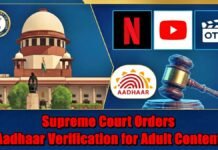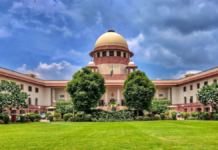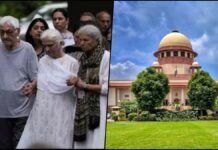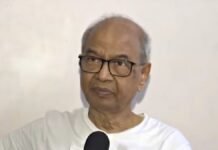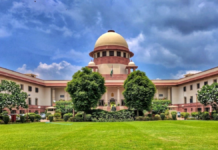
Key Points:
- Allahabad High Court sternly warned the Supreme Court on Wednesday, October 29, 2025, to adopt a “hands-off approach” and stay away from district judiciary matters, marking a major judicial confrontation
- The two-decade-long controversy centers on who has authority to frame service rules for state judicial officers, including recruitment, promotions, and retirement age
- Senior advocate Rakesh Dwivedi, representing Allahabad High Court, argued that Article 227(1) of the Constitution grants High Courts superintendence over district judiciary
- A five-judge Constitution Bench led by Chief Justice B.R. Gavai is examining criteria for determining seniority in Higher Judicial Services, affecting promotion paths for district judges
- The disputed promotion quota ratio of 50:25:25 (seniority-based, direct recruitment, and limited departmental examination) was established in 2002, changed to 65:25:10 in 2010, and restored to 50:25:25 by the Supreme Court
- Multiple High Courts, including Punjab & Haryana, Kerala, Bihar, and Delhi, have opposed Supreme Court interference in their recruitment and promotion procedures
New Delhi: A major constitutional confrontation erupted on Wednesday, October 29, 2025, when the Allahabad High Court bluntly told the Supreme Court to adopt a “hands-off approach” over framing service rules for state judicial officers. The High Court, which has faced recent criticism from the Supreme Court for delays in deciding cases, asserted that “the SC should leave it to the HCs to chalk out the framework for ensuring adequate promotional avenues to career judicial officers and direct recruit district judges”.
Senior advocate Rakesh Dwivedi, representing the Allahabad High Court before the Constitution Bench, presented sharp arguments questioning the Supreme Court’s authority in this domain. He stated emphatically, “Why should the high courts be divested of their authority and duty under the Constitution? It is time to strengthen the HCs, not weaken them. Things have gone too far”.
Article 227 and High Court Powers
The core of the dispute revolves around Article 227(1) of the Constitution, which grants High Courts superintendence over all courts and tribunals in their territorial jurisdiction. This constitutional provision empowers High Courts to exercise both administrative and judicial supervisory powers over subordinate courts, independent of appellate or revisional jurisdiction.
Dwivedi argued that under Article 227, High Courts should possess the authority to formulate service rules covering recruitment, promotion, and retirement age for the district judiciary. He contended that the service conditions vary significantly from state to state, and the High Court is in the best position to consider these aspects while framing service rules.
Supreme Court’s Position on Uniformity
The Constitution Bench comprising Chief Justice B.R. Gavai and Justices Surya Kant, Vikram Nath, K Vinod Chandran, and Joymalya Bagchi clarified that the concept of an All India Judicial Service remains under consideration. If this concept materializes, the Supreme Court may have a role in framing uniform service rules for the district judiciary.
Justice Surya Kant, who will become the next Chief Justice of India, emphasized, “The purpose of the present proceedings is not to usurp the powers of HCs in relation to the district judiciary. We are considering whether a general guideline is needed to bring in some uniformity in promotions to the post of district judge”. Chief Justice Gavai added, “We do not even remotely intend to take away powers of the HCs”.
The Promotion Quota Controversy
The immediate flashpoint concerns the three pathways to becoming a district judge: promotion based on seniority-cum-merit, direct recruitment from the Bar, and Limited Departmental Competitive Examination (LDCE). In 2002, the Supreme Court established a ratio of 50:25:25 for these three categories, which was later modified to 65:25:10 in 2010 before being restored to 50:25:25.
The controversy affects how judicial officers progress through their careers, with significant implications for thousands of judges across India. The current system often disadvantages promoted judges who typically reach district judge level in their mid-40s after years of lower court service, while direct recruits from the Bar often join in their mid-30s.
Structural Disadvantage for Career Judges
Data presented to the Constitution Bench reveals stark disparities between promoted judges and direct recruits in reaching senior positions. In Bihar, out of 91 Principal District and Sessions Judges, 86 are direct recruits while only five are promotees, even though promotees constitute the majority of the district judge cadre.
In Uttar Pradesh, of 70 District and Sessions Judges, 58 are direct recruits and only 12 are promotees. The Allahabad High Court stated in its affidavit that among the 100 senior-most officers, 81 were direct recruits, with the senior-most promotee judge appearing at Serial No. 29 in the seniority list.
Multiple High Courts Oppose Interference
The Allahabad High Court is not alone in resisting Supreme Court intervention. Senior advocate Maninder Acharya, representing the Punjab and Haryana High Court, argued that the present system works well in both states and there is no need for the Supreme Court to create a quota for career judicial officers.
Representatives from Kerala, Bihar, and Delhi also supported the position that the Supreme Court should not modify the existing promotion procedures. Dwivedi concluded his arguments by stating that the Supreme Court should intervene only when the judicial system breaks down or when a High Court is unable to manage the affairs of the subordinate judiciary.
Historical Context and 2017 Standoff
This confrontation has roots stretching back two decades, with tensions occasionally surfacing over the Supreme Court’s role in regulating the subordinate judiciary. In 2017, the Supreme Court finalized a concept paper advocating that it should conduct recruitment tests for direct appointee district judges from among advocates.
Dwivedi recalled, “We protested and it was stalled. SC can’t be fixing retirement age, quota for the career judicial officers, and eligibility”. The current proceedings stem from the All India Judges Association case, in which the Supreme Court undertook to standardize the service structure and conditions of the subordinate judiciary.
Impact on High Court Elevations
The seniority and promotion system directly affects which judges become eligible for elevation to High Courts under Article 217(2) of the Constitution. The post of Principal District and Sessions Judge serves as the stepping stone to the High Court bench, but promotee officers often reach this level close to retirement, leaving little time for consideration for elevation.
Between 2020-2025, data shows that direct recruits disproportionately receive High Court appointments compared to promotee judges. The Bombay High Court reported that of 19 district judges elevated to the High Court since 2020, 16 were direct recruits and only three were promotees.
Broader Implications forthe Judiciary
The outcome of this constitutional standoff will have far-reaching implications beyond service rules for the foundation of India’s justice system. Fair and predictable career paths affect institutional morale and the diversity of experience at higher judicial levels.
The debate raises fundamental questions about federalism, judicial independence, and the balance of power between the Supreme Court and High Courts in administering India’s vast subordinate judiciary. As the Constitution Bench continues its hearings, the resolution of this historic conflict will shape the career trajectories of thousands of judicial officers and potentially redefine the constitutional relationship between India’s apex court and the High Courts.






































